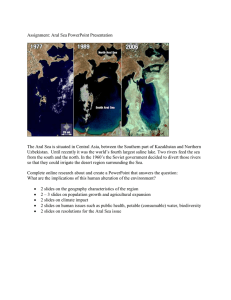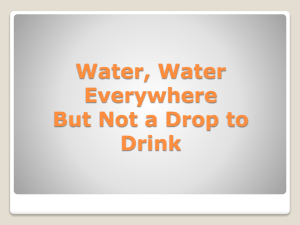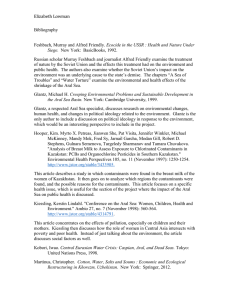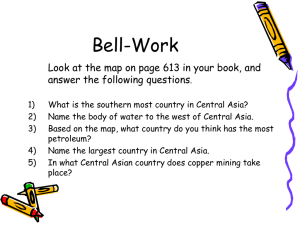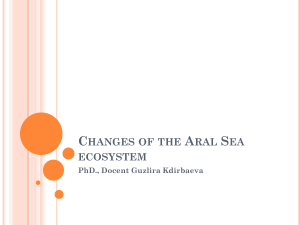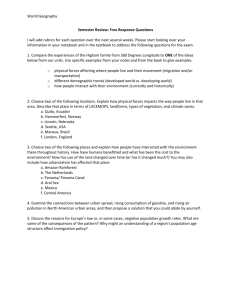Aral Sea Disaster: Causes, Effects & Improvement Efforts
advertisement
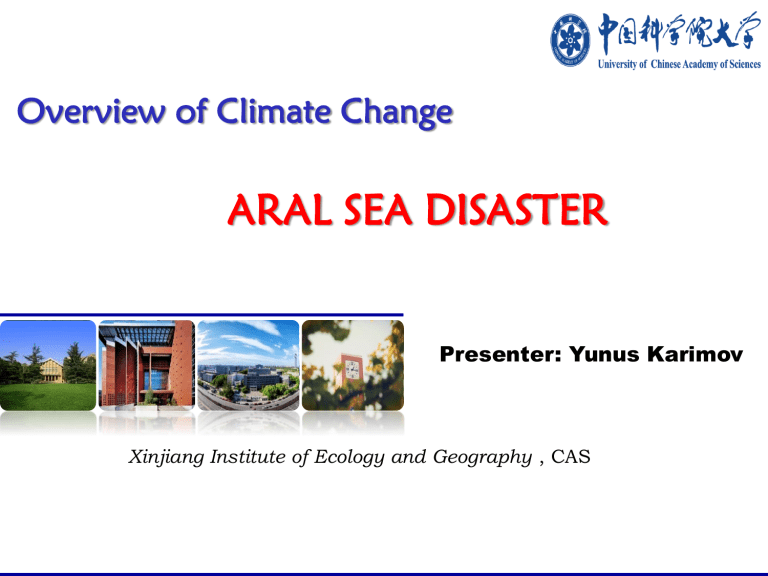
Overview of Climate Change ARAL SEA DISASTER Presenter: Yunus Karimov Xinjiang Institute of Ecology and Geography , CAS Contents 1. Introduction. 2. The Disaster. 3. III Effects. 4. Improvement Efforts. 5. Measures to be taken 2 Introduction 3 Location 4 Location • The Aral sea is in the middle of the Central Asian Desert. • Summer temperatures rise to over 40oC. • The Aral Sea is fed by 2 rivers Syr Dar’ya & Amu Dar’ya. These rivers rise in the mountains to the South. • There is no outlet river. 5 Aral Sea The 60th of the 20th century The beginning of ХI century 6 By 2007, it had declined to 10% of its original size, splitting into four lakes – the North Aral Sea, – the eastern and western basins of the once far larger South Aral Sea – one smaller lake between the North and South Aral Seas. By 2009, the southeastern lake had disappeared and the southwestern lake had retreated to a thin strip at the 7 extreme west of the former southern sea. The Aral Sea is gradually shrinking & drying up. 8 Satellite images taken by NASA in August 2014 have revealed that for the first time in modern history the eastern basin of the Aral Sea had completely dried up. The eastern basin is now called the Aralkum desert. 9 The Disaster 10 During the Soviet era Uzbekistan was designated as a major cotton growing region of the USSR. Cotton is known as “white gold” & is highly profitable to grow. • To make cotton grow in a desert large quantities of water are needed (Irrigation). •Large dams were built across both rivers, and an 850-mile central canal with a farreaching system of "feeder" 11 canals was created. •This reduced the flow of water reaching the Aral Sea. •When the irrigation system was completed, millions of acres along both sides of the main canal were flooded and the water flow was decreased dramatically. 12 Due to irrigation projects, its surface area declined by more than 50 %, to 30,000 sq km from 67,000 sq km, between 1960 and 1996. Aral Sea 1964 area 64800 km2 2001 год area 21100 km2 100% 32,5% 2013 год area 8730 km2 13,5 % The desiccation dynamics of the Aral Sea 13 It was not until after the construction of the irrigation ditches were completed that problems began to occur. With the loss of the water flow to the Aral Sea, the water level began to drop. Aral Sea 53 m (1960) by 29 meters 24 m (2013) 2013 Level of water 1960 Reduction of water surface by 8 times 14 III Effects 15 Over the next 30 years, the Aral Sea experienced a severe drop in water level, its shoreline receded, and its salt content increased. The salt content of the lake is now three times what it is in the ocean. Aral Sea Ocean Aral Sea 120-280 (g/l) 18-24 (g/l) Level of salinity - has increased by more than 13-25 times - exceeds average mineralization level of the 16 World ocean by 7-11 times Fishing Industry Dies… • Because there was too much salt in the water it began killing the plants and animals. • All 20 species of fish that once lived in the Sea are now extinct. • As the marine life died, the fishing industry suffered. • The once thriving fishing industry employing roughly 60,000 people in the early 1960s has been destroyed. Old fishing boats in dried lake bed. 17 Effects on Climate • Due to the recession of the Aral Sea, the climate has changed ... • Lakes and seas tend to have a moderating effect on the climate. • In other words, the land right next to a body of water tends to be warmer in the winter and cooler in the summer than land that's not near the water. • As the has Aral Sea has lost become more extreme Winters have become harsher and longer. Summers hotter and shorter. water, the climate 18 Pollution cases • More serious was pollution from a range of toxic chemicals. • Large quantities of fertilizer, insecticides, herbicides, defoliants etc were applied to the cotton. • These chemicals were returned to the rivers with the remaining irrigation water & eventually ended up in the Aral Sea. 19 Extinction of wildlife The wetlands of the river deltas dried out, drastically affecting the wildlife of the area. More than half of the plant and animal gene pool of the Aral Sea region has disappeared, with 11 species of fish, 12 species of mammals, 26 types of birds and 11 species of plants 20 nearly gone. Salt and Dust in the air… • An effect of the reduction in the Aral Sea’s size is the exposure of the lake bed. Today, strong winds blow the exposed land picking up and depositing tens of thousands of tons soil every year. • This process has contributed to significant reduction in breathable air quality for nearby residents • It has also affected crop yields due to those heavily salt-laden particles falling on arable land. 21 Once prosperous seaside villages were left “high & dry” many kilometres from the receding sea this caused further problems. • Local wells have dried up as the water table has dropped. •Unemployment rose rapidly, people began to migrate away from the area. 22 • Perhaps the biggest problem has been a decline in the health of the local inhabitants. • The chemicals have seeped into the local water supply causing a wide range of health problems such as cancer, tuberculosis, deformities in babies, liver & kidney failure, anaemia, lung disease & high infant mortality etc. Polluted water Signing up for health care A TB sufferer Infant Mortality & childhood illnesses have increased. 23 Improvement Efforts 24 DEVELOPMENT INITIATION • Aral Sea Basin program Kazakhstan, Uzbekistan, Tajikistan, Kyrgyzstan, and Turkmenistan. • The Program’s three objectives are: – To stabilize the environment of the Aral Sea Basin – To rehabilitate the disaster area around the sea – To build the capacity of institutions at the regional and national level to advance the program’s aims 25 ROLE OF INTERNATIONAL ORG. FOR IMPROVEMENT • The international donors conference, which was held in Paris in June 1994 with wide participation of the Uzbek governmental officials, identified the three main investment areas: Potablewater Basicsanitation Healthcare 26 Uzbekistan‐ Water Supply, Sanitation and Health project The project has 2 objectives: •The provision of the safe drinking water along with the improved hygiene education and sanitation facilities. •Regional centres of Health and the Sanitary Epidemiological Services 27 Projected Costs: The total projected cost is $117 million. Divided in three component: 1. Water Supply and Distribution Component 2. Sanitation, health and Hygiene Component 3. Technical assistance 28 BREAK DOWN OF THE COST Water supply and distribution US$ 68.2 million Sanitation, health and hygiene US$ 11,2 million Technical assistance US$ 2 million : Main Pipeline System (US$ 38,8 Rural Sanitation (US$2,0 million) million) Institutional Strengthening of Water Utilities and Bulk Providers (US$ 6,7 millions) Development of Local Supply Health promotion and Hygiene and Distribution Systems (US$ Education (US$ 4,0 million) 21 million) Water Demand Management Water Quality Monitoring and and Loss Reduction (US$ 3,3 Strengthening of Sanitary million) Epidemiological Services (SES) (US$ 5,2 million) Tariff Study (US$ 0,6 million) Refinancing Feasibility Study (US$ 0,8 million) · Equipment foe operation and maintenance (US$ 5,2 million) 29 Measures to be taken 30 • Many different solutions to the problems have been suggested over the years, varying in feasibility and cost, including: o Improving the quality of irrigation canals o Installing desalination plants o Charging farmers to use the water from the rivers o Using alternative cotton species that require less water o Promoting non-agricultural economic development in 31 o Using fewer chemicals on the cotton o Cultivating crops other than cotton o Installing dams to fill the Aral Sea • Redirecting water from Volga, Ob and Irtysh Rivers to restore the Aral Sea to its former size – 20–30 years. – cost of US$30–50 billion. • Pumping sea water into the Aral Sea from the Caspian Sea via a pipeline, and diluting it with fresh water from local catchment areas. 32 THANK YOU 33
